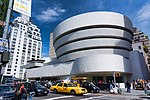Jacqueline Kennedy Onassis Reservoir

The Jacqueline Kennedy Onassis Reservoir, also known as Central Park Reservoir, is a decommissioned reservoir in Central Park in the borough of Manhattan, New York City, stretching from 86th to 96th Streets. It covers 106 acres (43 ha) and holds over 1,000,000,000 US gallons (3,800,000 m3) of water. Croton Aqueduct Board president Nicholas Dean proposed the construction of Central Park around its receiving reservoir (later the Great Lawn and Turtle Pond) in the 1850s. As part of this project, the Central Park Reservoir was completed in 1862. The reservoir was decommissioned in 1993, after it was deemed obsolete, and control was transferred to the Department of Parks and Recreation in 1999. The Central Park Reservoir was renamed in honor of Jacqueline Kennedy Onassis in 1994 to commemorate her contributions to the city, and because she lived nearby.
Excerpt from the Wikipedia article Jacqueline Kennedy Onassis Reservoir (License: CC BY-SA 3.0, Authors, Images).Jacqueline Kennedy Onassis Reservoir
Stephanie and Fred Shuman Reservoir Running Track, New York Manhattan
Geographical coordinates (GPS) Address Nearby Places Show on map
Geographical coordinates (GPS)
| Latitude | Longitude |
|---|---|
| N 40.785088888889 ° | E -73.960475 ° |
Address
Stephanie and Fred Shuman Reservoir Running Track
Stephanie and Fred Shuman Reservoir Running Track
New York, Manhattan
New York, United States
Open on Google Maps






